Co-authored with Jessye Wdowin-McGregor, Preservation Technician
Some companies preserve and conserve food stuffs, but here in Collection Care, we preserve and conserve Victoria’s cultural heritage. Which, fittingly enough, now includes archival material from the Rosella Preserving Company, an iconic Australian business celebrated for its sauces, pickles, canned fruits, jams, soups and vegetables. ‘Rosella’ is a name familiar to many households with the colourful parrot logo adorning its products, including the pantry staple tomato sauce.
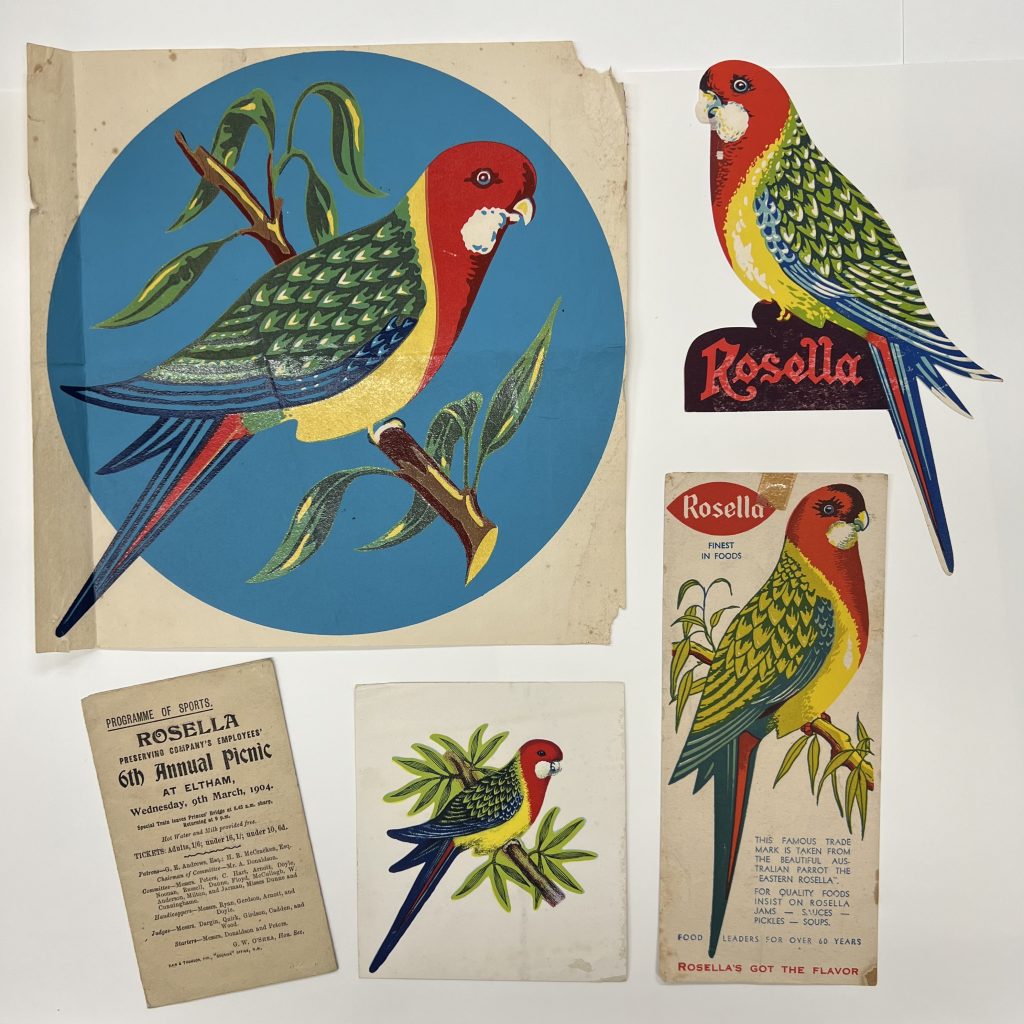
Rosella logo design and ephemera
An individual with a keen eye for history rescued the collection from disposal during a change of company ownership and kindly donated it to the Library. The Collection Curation & Engagement team appraise and may acquire material offered as a donation.
Upon arriving at the Library, the material comprising the Rosella Preservation Co. (YMS 16499) collection came through Quarantine, where Preservation staff assess newly acquired collection material to ensure it is free from contaminants like dirt, pests, and mould. This important first stage in a collection’s journey through the Library prevents cross-contamination with existing collection items and allows for safe access by staff and patrons.
An oversized company record book from the 1940s containing monthly production details of tinned and bottled goods intrigued us with offerings like ‘Gherkin Paste’, ‘Cocktail Tomato’, ‘Coffee Essence’ and ‘Oxtail soup’, just to name a few! A layer of dust and dirt had settled on its pages, requiring a thorough brush-vacuuming treatment. Due to its large scale, the record book was cleaned in tandem, with dust gently brushed into the nozzles of two separate vacuums, top to bottom, page by page. Debris and spider webbing on the ledger text block and covers, were also vacuumed. Extra attention was given to areas of the spine which had spilt in places, and which may have provided a good hiding place for insects.

Preservation Technicians Jessye and Savina brush-vacuuming the oversized record book

Close view of cleaning debris from the record book
During this page-by-page treatment we glimpsed the everyday operations of the factory. A vivid snapshot of the working conditions and processes of the time are all carefully recorded, including the number of staff employed, wages, energy resources, and production summaries.
Amongst the assorted business records were two tightly locked ledgers, with no corresponding keys in sight… we found ourselves in a bit of a pickle! In order to assess, clean and make the items accessible, we called upon the talents of our colleague Gerard Hayes, a Librarian in the Description Original Materials team. Gerard’s reputation as a talented lock-picker is well known amongst library staff, and it’s not the first time his nimble-fingered skills have come to good use. Thanks for getting us out of a jam, Gerard!
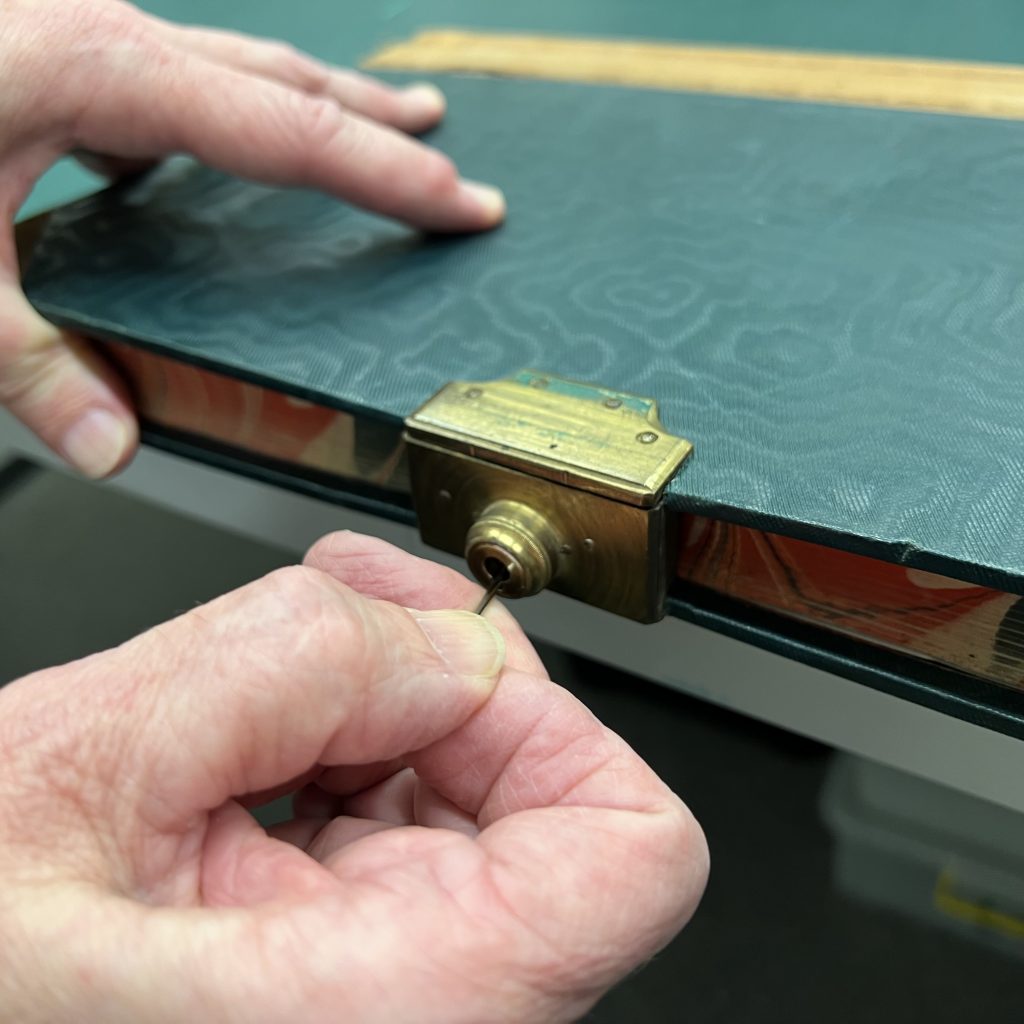
Gerard at work, lock-picking one of the ledgers
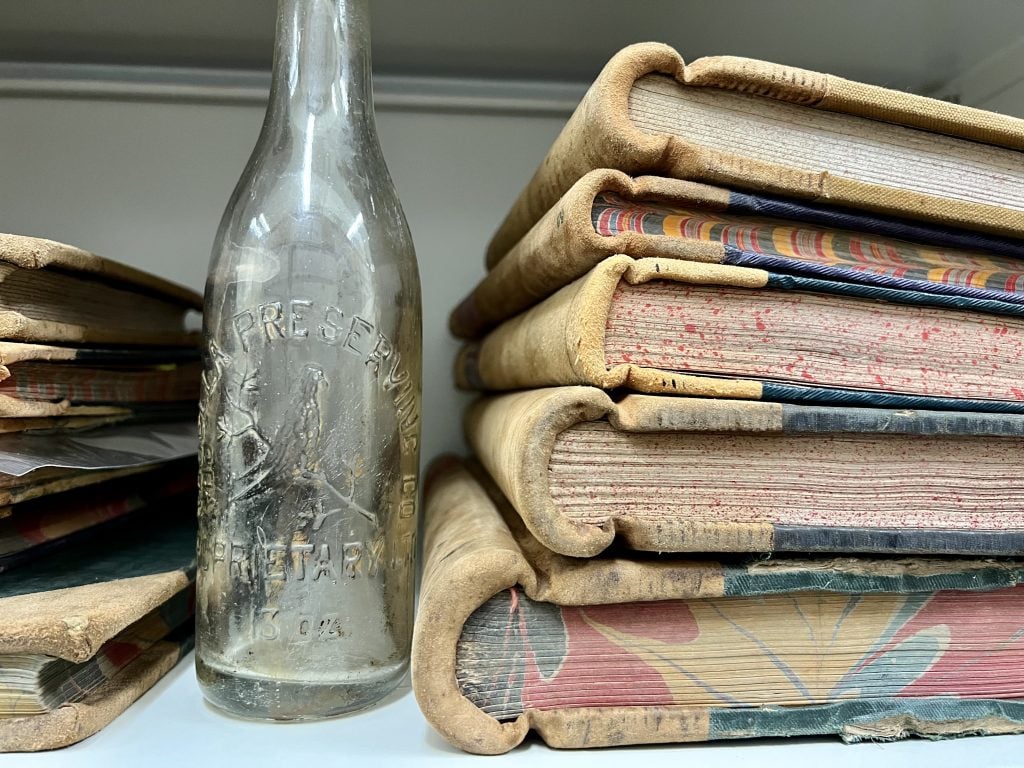
Glass bottle and ledgers awaiting assessment in Quarantine
How did the Eastern Rosella become a symbol for sauce?
It is thought that company founders H.R. McCracken and T.J. Press, a commission agent and grocer respectively, witnessed a large flock of Eastern Rosellas flying over the back yard in Carlton where the two men started making jams and preserving fruits in a copper pan in the1890s – inspiration struck and thus ‘Rosella’ as a brand name was born. An alternate origin story proposes the combination of the first names of one of the men’s sisters or daughters, Rose and Ella. However it came to be, the colourful southeastern Australian native bird became synonymous with sauce and an extensive range of tinned goods. Rosella’s Tomato Sauce was first introduced in 1899.
We learnt that the original Rosella factory and head office in Richmond has interesting ties to Melbourne’s early settler history, as it was situated on the site once home to Cremorne Gardens, an ambitious but short-lived amusement park on the bank of the Birrarung (Yarra River). Growth in production also resulted in additional factories and branches in Windsor, Bendigo, Tatura, Hobart, Sydney, and Adelaide. More fascinating insights, including the impacts of war, changes in production processes, technological developments, and even the engagement of a bacteriologist, can all be gleaned from a comprehensive booklet tracing a timeline of the company from 1895-1963.
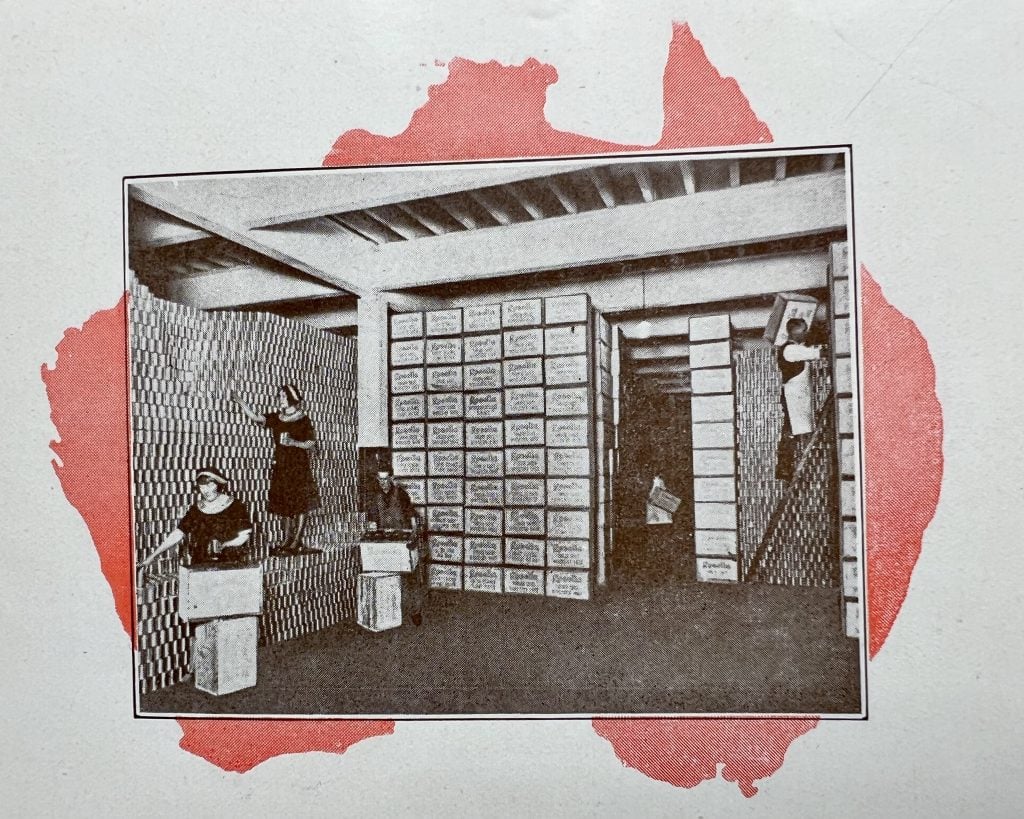
Packing cans in the factory

Front cover of souvenir booklet
Iconic packaging and design
A valuable component of this collection is undoubtably the wonderfully designed packaging labels. Housed within two large ledgers are dozens of excellent examples of Rosella’s commercial offset colour lithography labels.
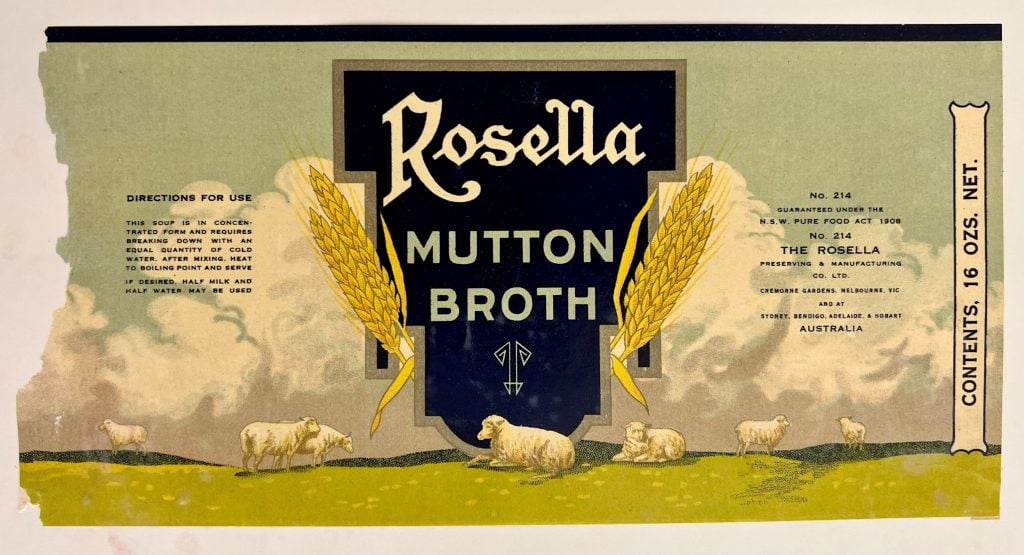
Changes in graphic styles emerge as we leaf through the pages of designs. Through observation we can begin to trace the design evolution of the iconic rosella bird logo and associated products and packaging. We notice the parrot logo has changed stylistically over time. There is a trend away from the use of beautifully rendered graphic illustrations to more literal photographic images of products, and the Rosella typeface has undergone various iterations.
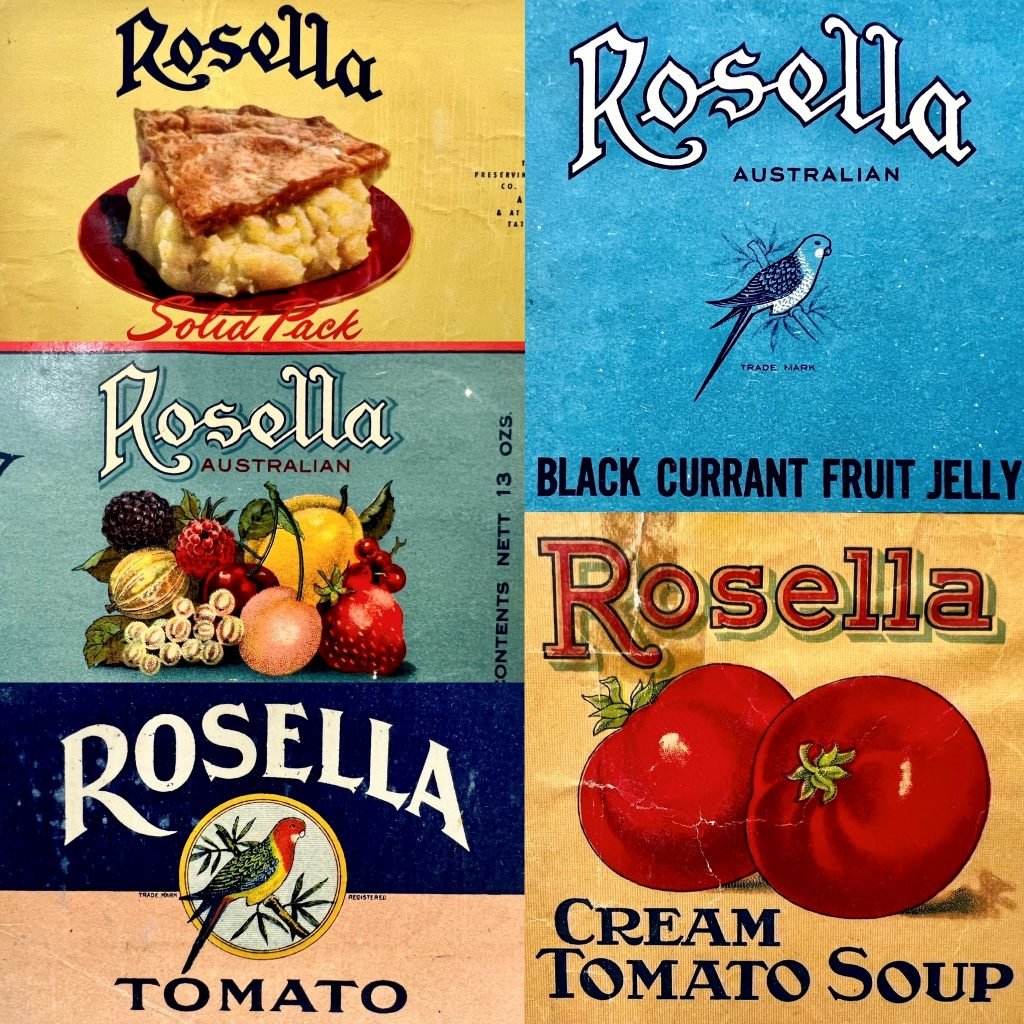
We notice some popular fruits were consistently produced but specificity of variety was lost over the years (i.e., ‘Bartlett’ pears, ‘Mira’ plums). Perhaps this foreshadowed the eventual diminished range of products – today, just a handful of classic staples continue to be produced and sold, the ever-popular and ubiquitous tomato sauce being the front runner.
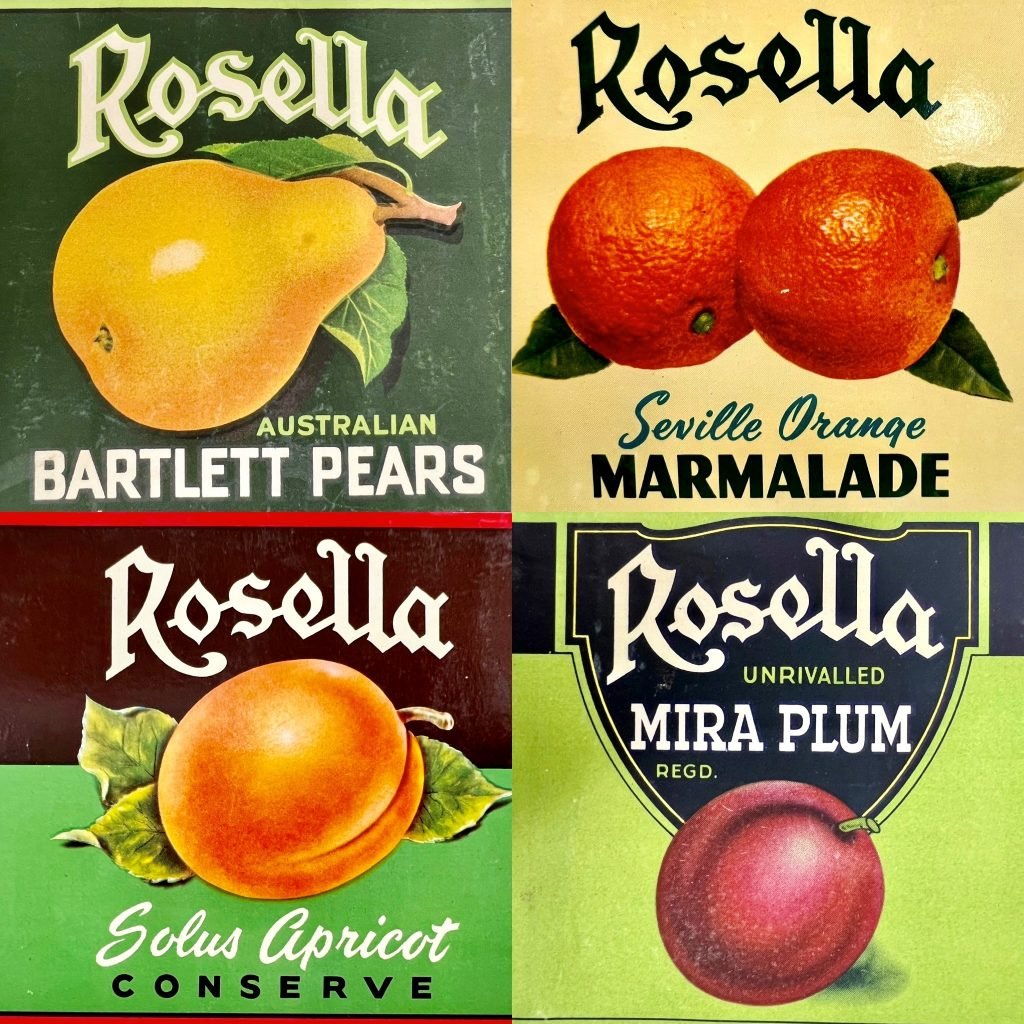
There are some canned foodstuffs of the past that caught our eye, such as whole chicken in jelly, beans and franks, kidney soup and game soup. The type of game is not specified but the illustration on the label closely resembles a type of quail.


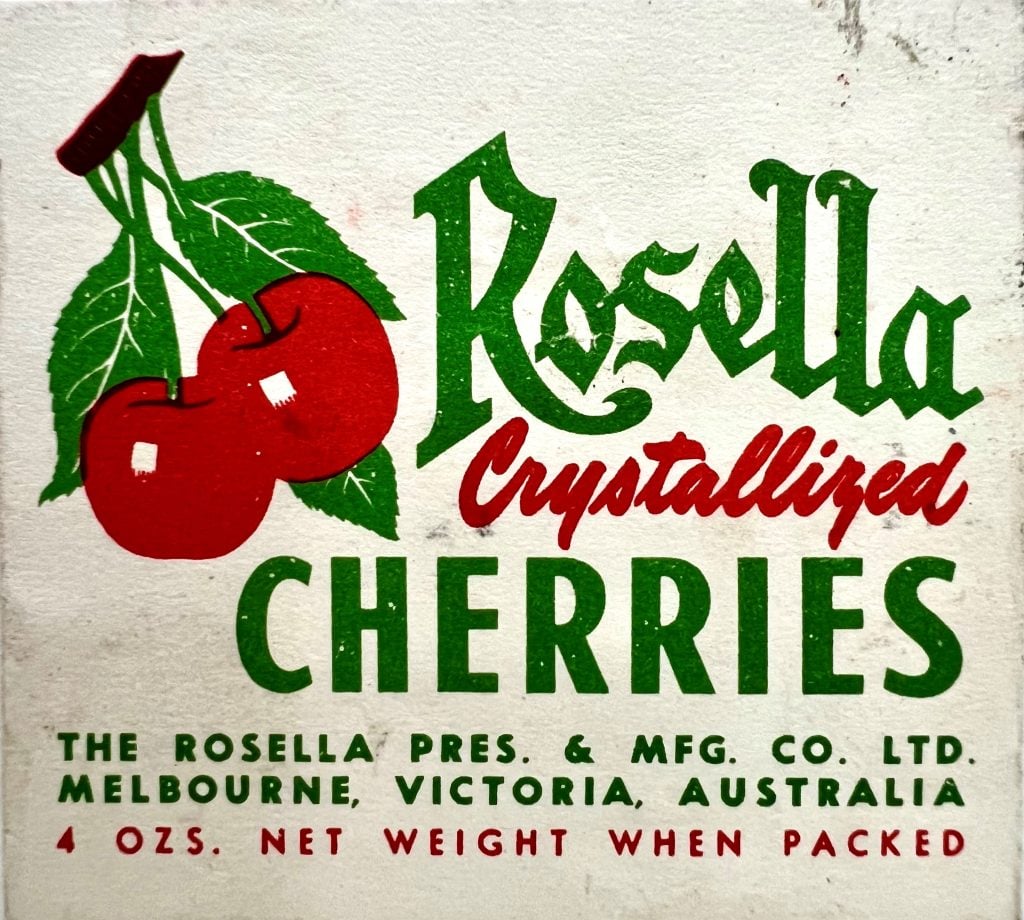
Ingredients were not generally listed on labels until the appearance of diabetic and dietetic branded foods, alerting consumers to useful nutritional values such as sugar and salt free goods.
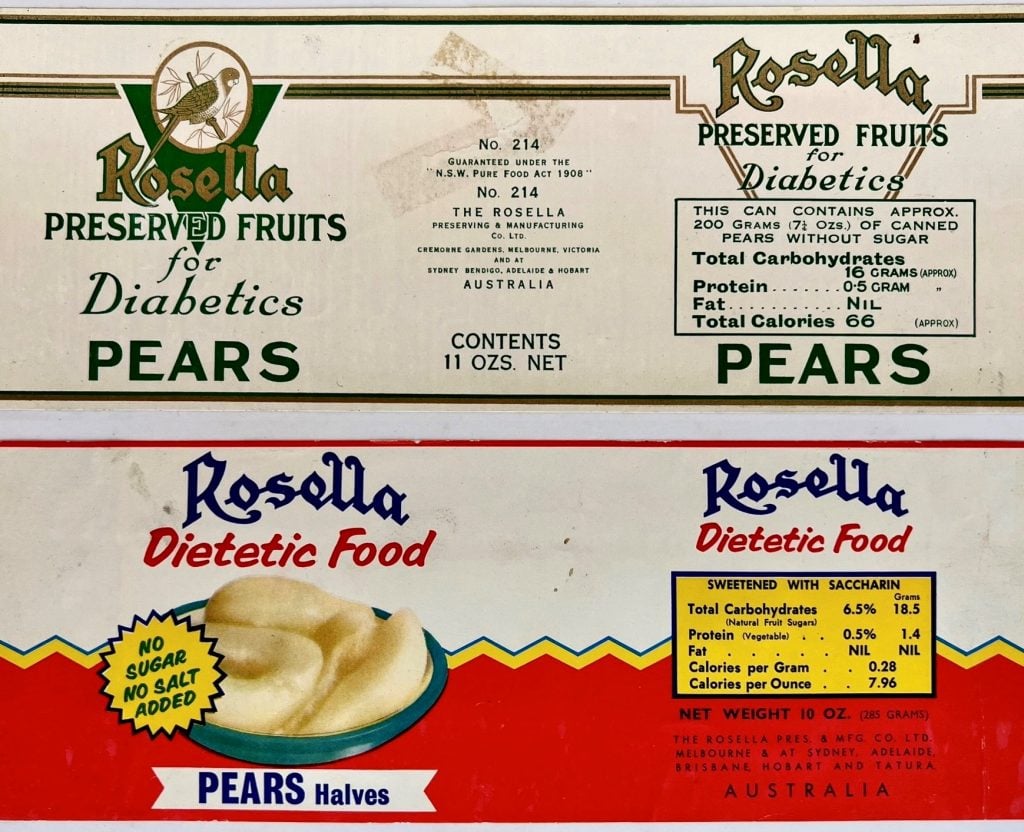
Collection gem, a trip to Antarctica
Amongst the business papers, we found a signed handwritten letter by renowned explorer Douglas Mawson, thanking the company for food preparations provided to the Antarctic Research Expedition of 1929-1930.

The letter reads – “The Expedition has been well stocked with many items of your excellent food preparations. I have pleasure in advising that in every case these preparations left nothing to be desired either in the matter of quality or packing. Rosella preparations set a high standard.”
This historic letter is just one of the many treasures that can be discovered within our collections. Now that the Rosella Preservation Co. (YMS 16499) collection has been carefully treated in Quarantine it is ready to be accessioned, catalogued and rehoused. Once this process is complete, this wonderful archive will be accessible to the public for further exploration.


What would we do without the keen individuals with an eye for history and the culture of the society we live in. Thank goodness they rescued this collection from disposal. Shameful that the new owenrs of the “records” disregarded their worth to society. “Anonymous individual” …. thank you 🙂
Thanks Debra, it really is a fabulous collection, a colourful snapshot of its time. We’re so pleased we can preserve it!
As soon as I saw the name Rosella some memories started flooding back. As a 14 year old I left school and went to work in the office of P.Pullar & Nephew Orchardists in Ardmona Victoria. My father was a foreman on the orchard and we lived in a company house. I had two brothers and we attended the local primary school.
The orchard mainly produced pears and it was one of the largest in area 365 acres if my mind serves me correctly. I clearly remember loads of pears going down to Rosella.
I am 76 and have been living in Brisbane for some years. Dad worked there for 45 years and three generations of the Pullar family moving into Mooroopna when he retired.
Thanks so much for sharing your memories Kay.
It’s a collection well worth preserving in my opinion. I have fond memories of my parents always having Rosella tomato sauce and soup in the kitchen cupboard and I still buy it. Thank you. Good work.
Thank you Eileen, we really enjoyed working on this collection.
Thanks for the terrific article – informative and witty!! What a fascinating collection!
Thanks so much Jean! We agree, it’s such an appealing collection, full of visual delights and historical insights.
In 1939/45 I lived near the Rosella {we kids called it The Joey) I remember the sounds and smells which covered South Richmond (now called Cremorne) and can still hear the rattle of the cans as they moved down the lines being filled when the factory was producing tomato soup or a fragrant jam (conserve). In season semi trailers from Northern Victoria would queue up at the Gwynne Street entrance loaded with tomatoes apricots pears or other fruits.South Richmond was an industrial suburb and dozens of identifiable factory whistles sounded a chorus at morning and closing time. Crowds of workers from Rosella poured down Gwynne Street to Richmond station at knock off time and I as a paper boy would easily sell 100 copies of the Herald in 30 minutes.I bought my first bottle of Coca-cola in the Rosella canteen priced two pence! I am 93.
Alan, what a wonderfully evocative recollection of this period in Richmond! We can vividly imagine the sights, sounds and scents you describe so well. Thank you for sharing your personal experience.
That is such a beautiful description! Thank you for sharing it Alan. Do you know why it was called “The Joey”?
I too echo the sentiments of the contributors… I lived in Tatura with my husband and three daughters from 1976 to 1980. The tomato season was always very pronounced with the tomato sauce fragrance encompassing the town.
Thankyou for an incredible overview of a company that has stood the test of time
Prudence Hassan. Mentone
Thanks Prudence, we’re so pleased you enjoyed it, and that it evoked some personal memories.
My Aunty Cath McCubbin worked with Rosella for many years as a comptometriste, using a little machine about the size of a typewriter to calculate figures for monthly accounts. And I’m still a committed Rosella person over Heinz. This is even after the mixed smells from Rosella and a neighbouring brewery invaded the classrooms of our high school across the river on hot afternoons.
Great to read this Bob, thanks for sharing your memories.
I remember driving between Murchison and Tatura many years ago and noticing all the Eastern Rosellas on the road side.
We then came on to the Rosella factory which made me think that was how the name was chosen.
Great well put together collection of memories.
Thanks Wayne!
What a fascinating and enjoyable read. Once again I wish these items could be on public display (along with the recently acquired Saunders Family Collection) because as a tour guide I know what a huge drawcard they would be for the public.
Tomorrow I’ll be taking a group on the Dome to Catacombs tour which involves a stop outside the Quarantine Department so I’ll be able to tell our visitors about this new addition to the collection.
Thanks Isabel. The Saunders Family Archive and Rosella Preservation Co. are still being rehoused and catalogued. They are quite large and complex collections and take a little more time before they are available on the catalogue and for the public to access. Stay tuned!
My mother worked for Rosella in Bendigo. In 1940 she was able to transfer to Richmond
where she met my dad and married two years later. My mother told me of how friendly it
was to work there. and easy to make friends. I did see a photo of her sitting with a group
of woman. When she left someone gave her a little cardboard cut out of the Rosella. She had it for many years.
I had heard that Rosella was back in Aussies hands again. Hoping for more icon companies to come home.
What a lovely story, thanks Faye. Wonderful to hear of your mother’s time at Rosella, sounds like a convivial workplace!
I live in the street where Rosella now Unilever ,they’re number 55 I’m 69. I worked seasons on tomatoes, my boss was Ian (Chisel) Martin, Ian worked in Richmond ,he relocated to the Tatura plant where he worked till his retirement .
Thanks Wendy – tomatoes being the essential ingredient for Rosella’s iconic sauce!
Really interesting … I am so glad that there are still people who notice , see and act on the value of items of the past … I for one absolutely love this type of article ..afterall its like a museum nursery isnt it …in a few hundred years these things will be seen as special and quaint ..:)
We agree Judy – we’re so fortunate to have been given this archive for the State collection.
What a wonderful collection. Cremorne was a rich powerhouse of Industry – for such a small area it had has a rich industrial history. Thanks for sharing
Thanks for reading Thomas!
Thank you for a very nostalgic trip to the past. My grandmother lived on Dover St and my cousin went to Cremorne primary school. Living in Gippsland, it was a long and enjoyable 2hr ride to visit them. All the little terrace houses, my grandmothers painted a sky blue, was a loving memory for me. It also involved the strange smell that blanketed the area, it was the Rosella factory..lol. As a small child, this was not appreciated by my nose but it wouldn’t have been the same without it..lol. This article brought back that smell to my senses and a poignant loss of what was so endearing to me. Thank you to the lovely person who recognised the value of this finding… and thank you to your staff as well on the huge job of preparing this collection for us to see.
Oh Kristina, it’s so enriching to hear these personal stories centered around the factory – and those vivid olfactory senses recalled! Thank you!
I lived in Cremorne Street in the 50’s and 60’s and remember well the smell of the cooking tomatoes!
Thanks Denise, sounds delicious! So many comments on this blog reference the cooking aromas from the factory – memories linked to a scent seem to be very vivid!
True locavores in those days – today the supermarket shelves are scandalously loaded with imported tomatoes.
Rosella tomato sauce was a staple in our kitchen cupboard. Growing up in Aspendale in the 60s, we had flocks of rosellas landing in our gum trees from time to time. They were a delight to see and hear. When travelling on the train to the city, I was always excited to see the bold signage on the brick wall of the Rosella factory at Richmond, depicting the familiar bird and emblem on our pantry sauce bottles. Thank you for the derived pleasure that this news of found archival material has given me. I await news that the collection will be ready for us to see on display. The conservation and preservation of iconic ephemera is integral to our understanding of the social & cultural history of our region. Good work.
Thanks Steve, we found this collection a pleasure to work on and write about. It’s wonderful to read your positive response!
I worked at Rosella in Richmond from 1968 to 1971 in the Development Department. It was interesting trying out possible new products. The factory was old by then but a friendly place to work. One of the perks of the job was to buy “cash sales”. These were tins which had wrong labels of no labels at all so mealtimes were a mystery until the tin was opened!
That’s a great little anecdote Christine – mystery meals and new products tastings…sounds like fun!
I remember travelling on the Sandringham line trains (some red, some blue, all great old rattlers, with leather seats, I’m pretty sure …) in the late 1970s and early 1980s, and depending on how the wind was blowing and whether the timber-framed train windows were open, especially in summer, there was very often an all-pervasive, heavy, chutney-like miasma before and after Richmond station coming from the Rosella factory. Like a tunnel of sauce fumes.
(Who knew that the Library has a champion lockpicker on staff? Surely Mr Hayes could be persuaded to get himself out of a few giant milk-cans or chains, as demonstrated by many of the magicians in the Alma collection?)
Thanks Kaz, another fabulous memory shared! I can’t help but hope all these stories coalesce into book / podcast / doco /mini-series. (I’ll pass on your thoughts to Mr Hayes, you just never know!)
The name “Rosella” is such an Australian icon. I cannot think of tomato sauce without thinking of Rosella. I loved reading this article and so glad that these treasures have been rescued and will hopefully be available for everyone to enjoy Everyone’s comments were also very informative and entertaining. My memory of the factory is very limited. We lived in South Melbourne but my godmother worked there for decades. I do not remember her working anywhere else. She would walk from her home in High St Prahran to the factory and back again. Her name was Stella and she was one of the many migrant ladies who worked there. She was Greek, very slim tallish lady., She was very loyal to the company and always spoke well of it. Wonder if anyone remembers her?